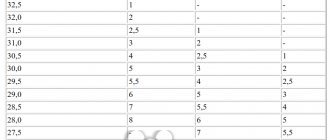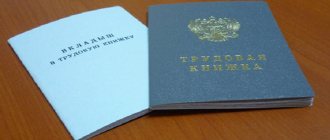How to use the calculator
Instructions for using the overtime calculator
- Enter the cost per hour for work in your organization. If you don’t know it, click “Calculate hourly cost”, enter the salary amount, select the accounting year and click on “Calculate hourly cost”. The program will calculate the cost of an hour using the formula: salary amount / (annual hours according to the production calendar / 12)
- Indicate how many hours and minutes of overtime were worked.
- Click "CALCULATE". The result will show both the total amount and separately for the first 2 hours and subsequent ones.
The overtime hours calculator works taking into account the requirements of Art. 152 of the Labor Code of the Russian Federation, that is, it includes in its algorithm payment differentiation depending on the number of overtime hours worked.
Official position
Rostrud believes that the provisions of the current legislation do not define the procedure for paying for rest time provided for overtime work.
This order is usually prescribed:
- in the employment contract;
- collective agreement;
- and/or internal regulations of the enterprise.
But it also happens that the procedure for paying additional rest for overtime work is not regulated by the listed documents. Then the additional rest time provided for overtime work IS NOT PAID.
In making its conclusion, Rostrud sees a complete analogy with an additional day of rest for working on a weekend or a non-working holiday.
At the request of an employee who worked on a day off or a non-working holiday, he may be given another day of rest (Part 4 of Article 153 of the Labor Code of the Russian Federation). In this case, work on a day off or a non-working holiday is paid in a single amount, and no one is obliged to pay for a day of rest.
Also see “We pay for overtime work according to the Labor Code of the Russian Federation.”
Standard calculation method
In accordance with Art. 152 of the Labor Code of the Russian Federation, overtime hours worked are paid according to the scheme outlined below:
- the first two hours of overtime work - at a coefficient of not less than 1.5;
- third and further hours of overtime work - at a factor of 2 or more.
The procedure for calculating payment is established at the local level through a collective agreement, individual employment contracts and relevant orders of the head of the enterprise or organization. At the same time, the procedure established at the local level should not worsen the employee’s position in comparison with the amount of payment established by the Labor Code of the Russian Federation.
The formula for calculating overtime hours is not regulated; however, Letter No. 16-4/2059436 of the Ministry of Health of the Russian Federation contains a completely workable calculation formula.
So, in accordance with the Letter of the Ministry of Health, overtime can be calculated by performing the arithmetic operation O / (GN / 12) = PO, where:
- O is the salary size;
- GN – annual norm according to the production calendar;
- 12 – months of the calendar year;
- PO – hourly salary.
For example, take the following hypothetical conditions.
Loader A. worked 3 hours overtime. The salary of a loader is 15,000 rubles. Taking into account a 40-hour work week, loader A. worked 1970 hours during the billing period. We calculate payment for overtime work:
15,000 / (1970/12) = 91 rubles 40 kopecks cost of one standard hour. Next, we calculate the hours taking into account the coefficient:
- 91.40 × 2 × 1.5 (one and a half coefficient) = 274 rubles 20 kopecks payment for the first two overtime hours;
- 91.40 × 1 × 2 = 182 rubles 80 kopecks for the third overtime hour;
- 272.20 + 182.80 = 455 rubles payable for 3 overtime hours.
What is overtime work
The definition of overtime work is given in the Labor Code of the Russian Federation, namely in Article 99 of the Labor Code of the Russian Federation. An employee’s work is counted as overtime if his activity exceeds the established norms of a working day or shift. One more condition must be met: the initiator of the delay is not the employee, but the employer. Therefore, before overloading an employee beyond the norm, you need to obtain official written consent from him.
If the organization has adopted a summarized accounting of working hours, then off-hour work activity will be work that exceeds the norm established for a certain working period. Duration - from one month to one year.
The standard working time is 40 hours per week (Article 91 of the Labor Code of the Russian Federation). Everything that is practiced above is extracurricular activities. Some positions require a shortened work week - 24, 35 or 36 hours. Employment in excess of this standard requires calculation of overtime hours per month with subsequent payment.
IMPORTANT!
It is not allowed to overload employees with more than 4 hours of labor for two days in a row and 120 hours a year in total (Part 6 of Article 99 of the Labor Code of the Russian Federation).
If an employee stays late at work on his own initiative, this is also considered overtime. But it is not recalculated and not paid. This is the main difference between overtime work assigned by a manager and overtime on his own initiative - the employer must calculate and pay for compulsory work beyond the norm.
If an employee’s employment agreement stipulates an irregular working day, then his employment beyond the established working hours will also not be considered overtime work and will be paid separately. However, employees with irregular working hours can count on additional leave. Article 152 of the Labor Code of the Russian Federation “Payment for overtime work” explains how overtime is calculated. Let's look at how to apply the calculation scheme established by law for various situations.
Calculation taking into account shift work schedule
When calculating the amount of payment for overtime hours during a shift work schedule, it is advisable to use the summarized accounting of working hours in the accounting period. The accounting period can be any period of time from one month to one year.
If we return to our example above about loader A. and slightly change the conditions, then the calculation will be made as follows.
With the previous salary of 15,000 rubles, we will take one month as the accounting period, during which the loader worked 176 hours, while the standard hours for the same month are 159.
In total, loader A. worked 17 hours above the norm. We make the calculation:
- we calculate wages for standard hours - 176 × (15000/159) = 16,603.77 for 159 hours;
- We calculate the additional payment for hours worked in excess of 17 hours. We multiply the first two hours by a factor of one and a half, all subsequent hours by a factor of 2. From the example above, we remember that an hour of work for a loader costs 91.40. Thus, 91.40 × 2 × 1.5 = 274.20 rubles. for the first two overtime hours and 91.30 × 15 × 2 = 2848.20 for the remaining overtime hours;
- We calculate the payment for 17 hours worked overtime - 274.20 + 2849.20 equals 3133 rubles payable.
Example of overtime payment
Let us immediately note that the algorithm for calculating additional payments that a specialist will receive for overtime work directly depends on the wage system and methods of recording working hours.
Let's look at how overtime hours are paid under the Labor Code, using specific examples.
Example No. 1. Payment of overtime work according to the Labor Code of the Russian Federation in 2021 with cumulative time accounting
Alexander the Bug works five days a week (40 hours). The salary of a specialist is calculated at an hourly rate of 200 rubles. In April, overtime was recorded at 5 hours. The April norm is 167 hours.
We make calculations using the summarized accounting of working hours:
- We calculate the total amount of time actually worked for the month (norm + overtime = 167 + 3 + 2 = 172 hours).
- We determine the processing hours (actual – norm = 172 – 167 = 5 hours).
- We calculate wages according to the tariff (rate × actually worked time = 200 × 167 = 33,400 rubles).
- We calculate the additional payment for the first 2 hours of processing (rate × coefficient 1.5 × 2 hours = 200 × 1.5 × 2 = 600 rubles).
- We calculate the additional payment for the remaining processing period (rate × coefficient 2 × BP = 200 × 2 × 3 hours = 1200 rubles).
- The total amount of the additional payment is 600 + 1200 = 1800 rubles.
- Total wages for April amounted to 33,400 + 1800 = 35,200 rubles.
Example No. 2. Payment for overtime work during a shift work schedule
Zhuchok Sergei works on a shift schedule. Its working hours: 2 working days (10 hours each) and 2 days off, a total of 15 shifts per month. Due to the illness of his partner Zhuchok S.A. worked 5 shifts more than normal. Wages are calculated at an hourly rate of 250 rubles. Let's do the calculation:
- The standard working time is 15 shifts × 10 hours = 150 hours.
- Actually spent BP (15 cm + 5 cm) × 10 hours = 200 hours.
- Recycling = 200 – 150 = 50 hours.
- Salary according to the standard 150 hours × 250 rubles. = 37,500 rub.
- Additional payment for overtime—RUB 24,750. (750 + 24,000) or (2 hours × 1.5 × 250 + (50 hours – 2 hours) × 2 × 250).
- Total salary for the month = 62,250 rubles. (37,500 + 24,750).
Example No. 3. Recycling on holidays
Strekoza Irina Petrovna works as an accountant (five days, 8 hours a day). In May, the standard working time for Dragonfly I.P. — 20 working days (159 hours). The official salary of an accountant is 50,000 rubles. per month or 314.47 rubles/hour (50,000 / 159). According to production needs, accountant Strekoza I.P. worked overtime on May 8 for 10 hours and on May 9 for 11 hours.
Step 1. Calculate processing hours:
- for May 8 3 hours (10 - 7 hours). We take into account only 7 hours, since the pre-holiday day is shortened;
- for May 9, 11 am - this is work on holidays, therefore, it is calculated exclusively in double size and is not included in the calculation.
Step 2. We calculate the salary according to the standard.
For a fully worked month, Strekoza I.P. The salary is 50,000 rubles.
Step 3. We calculate the additional payment for work on a holiday.
11 hours × 2 × 314.47 = 6918.34 rubles.
Step 4. Calculate the additional payment for overtime work.
For the first 2 hours = 2 hours × 1.5 × 314.47 = 943.41 rubles.
For the rest, time = (3 – 2 hours) × 2 × 314.47 = 628.94 rubles.
Total: 943.41 + 628.94 = 1572.35 rubles.
Step 5. Calculate the results.
The processing calculator showed that the accountant's salary for May = 50,000 + 6918.34 + 1572.35 = 58,490.69 rubles.
About the author of the article
Natalya Evdokimova Accountant-expert, practical experience - more than 15 years.
Author of articles in online media on accounting, taxes, and personnel issues.
How to use the calculator
There are a total of five windows in the calculator in which you will need to enter the following data:
- the cost of one working hour - in the first field;
- hours and minutes worked within the first two hours at a factor of 1.5;
- hours and minutes worked within subsequent hours at a factor of 2.
Immediately after filling out each field, an intermediate answer will appear, to which, as new values are added, adjustments will be made until the calculation is completed.
When does overtime work not require the employee's consent?
Working overtime unless the employer has the employee's written consent is illegal. The only exception is work after the end of the normal working day, caused by the need to:
- preventing a catastrophe, accident or eliminating the consequences of them, or the consequences of a natural disaster;
- eliminating breakdowns of centralized water, heat, gas, transport and communications systems;
- prompt elimination of the consequences of natural disasters, unforeseen circumstances in which the life or normal existence of people is at risk. The law allows an employer to involve an employee in overtime work in the event of martial law, a state of emergency or natural disasters.
How to apply correctly?
An application for days off for overtime is drawn up in any form. Some enterprises have forms approved by local regulations. This greatly simplifies the process of writing a document for an employee. An application is drawn up addressed to the head of the company.
The main structural elements of this paper:
- a cap . Located in the upper right corner. The addressee and addressee are indicated;
- Title of the document . It is written under the heading in the middle of the sheet. According to the rules, there is no need to put a period at the end of the word “Statement”;
- main text of the petition . It is requested to provide days off;
- final part . The date and signature are placed with the applicant’s transcript.
The document must contain the following information:
- details, company name;
- surname and initials of the manager;
- Full name (full name) of the employee;
- number of days off or hours;
- specific dates for providing days off or hours;
- days on which the employee was involved in overtime work;
- grounds for receiving time off;
- date of document preparation;
- personal signature of the applicant.
You can draw up a document by hand or using printing technology; in any case, it is important to adhere to a number of rules:
- write competently, concisely, to the point;
- don't make mistakes;
- do not correct the text using a proofreader or crossing out;
- write in legible handwriting;
- When typing text on a computer, do not use a copy of the signature;
- When drawing up a document by hand, use a blue or purple pen.
Dear readers! To solve your problem right now, get a free consultation
— contact the duty lawyer in the online chat on the right or call: +7 Moscow and region.
+7 St. Petersburg and region. 8 Other regions of the Russian Federation You will not need to waste your time and nerves
- an experienced lawyer will take care of all your problems!
Samples
An example of an application for leave for two days due to overtime work:
General Director of Tsvetok LLC
Seleverstova A.P.
accountant Ivanova Alla Stepanovna
Statement
I ask you to provide me with two additional days off, 10/22/2019 and 10/23/2019, for the previously processed time from January to October 2021.
10/21/2019 (signature) A.S. Ivanova
Sample application for reduction of working hours due to overtime:
General Director of Tsvetok LLC
Seleverstova A.P.
accountant Ivanova Alla Stepanovna
Statement
I ask you to provide me with additional rest time on October 24, 2019 from 15:00 to 17:00 in connection with the involvement in overtime work on 10/16/2019.
10/21/2019 (signature) A.S. Ivanova
Expert opinion
Irina Vasilyeva
Civil law expert
Overtime is accumulated over the course of a calendar year. Upon completion, the employee has the right to take additional days off or a cash payment.









